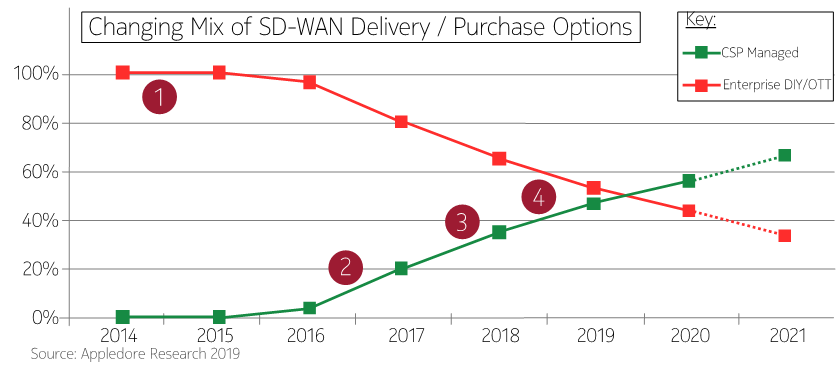In part two of this blog I’ll continue the story on the evolution of SDN into the Enterprise WAN where we focus on the complexities of early SD-WAN implementations, part one can be found here.
Self-operating the SD-WAN Platform
To get maximum control of the new SD-WAN network, the Enterprise had to make the decision to run the network in-house and for many Enterprises this was a significant shift in their operating model.
Many Enterprises had shifted to an outsourced model for their WAN 15-20 years ago with the purchase of managed IP-VPN services from their Service Providers. This allowed the Enterprise to reduce their networking teams size and to lift the remaining team members to a higher architectural role as the day-to-day operation and management functions had been outsourced.

With SD-WAN these management functions would need to be handled by Enterprise, installing a new branch, well now the WAN team needs to purchase the SD-WAN branch gateway and courier it out to the branch.
Next the transport service needs to be investigated (what’s available at the location, internet, fiber or copper, what bandwidth and traffic-plan etc.) and ordered.
Then when installed the branch staff need to be instructed on the zero-touch-provisioning process. I’ll let you in on secret here, there is some touching involved in ZTP… cables need to be connected to the right ports, Internet cable to WAN port 1, plug the LAN into port 6 etc. It’s not ‘connect your PC to the router’ and type in screens of configuration but there is a bit of physical connecting and authenticating to get the branch online which needs proper oversight.
For early SD-WAN implementation there is the resolving of issues when they arise. For example, say the primary connection to the branch fails and the branch automatically switches to an expensive mobile broadband connection with a fixed throughput plan. Who is monitoring the WAN to see the fault and who is responsible for doing the initial diagnosis? Who works out if it’s a cable issue in the branch or an outage on the Internet connection, and who pays for the mobile broadband charges?
There is also a cost of operating an SD-WAN platform within the Enterprise IT environment. Unlike the traditional router-based networks where the network management, control (routing protocols) and data plane (how the traffic gets from branch to branch) are all contained within each of the branch routers, with SD-WAN these functions are separated and centralized.
This means a set of compute servers need to sit inside the IT environment to perform these functions, be that the central policy manager (in redundant form) where the network policies are centrally managed and the SDN control plane that programs the SD-WAN branch gateways.
These servers need a level of IT management, feeding and watering to ensure that the SD-WAN platform has the capacity and reliability needed to deliver the WAN.
Some of the early implementations of SD-WAN uncovered these hidden costs and although they might not have been large enough to dissuade the Enterprise from continuing their SD-WAN “do it yourself (DIY)” deployments they would certainly have accelerated the conversations with managed service providers about managed SD-WAN service offerings.
As an industry trend we have seen a significant shift in the preferred deployment of SD-WAN by Enterprises with mid-2019 being the transition point identified by analysts as the cross over between Enterprises wanting to self-operate their SD-WAN platforms and those wanting to buy SD-WAN as a managed service.
A recent market report from Appledore Research highlights this trend in the graphic below. Here we see the early adopters of SD-WAN, in the 2014-2016-time frame being heavily based around a DIY implementation.
But as SD-WAN market penetration increased that the percentage of deployments began to trend towards managed offerings particularly around 2017, which was the year that most Communication Service Providers (CSPs) first started to launch managed SD-WAN services, such as BT with Agile Connect and Telus with NaaS.

The report from Grant Lenahan from Appledore Research captures the transition over time from Enterprise do-it-yourself and over-the-top SD-WAN to the procurement of SD-WAN as a managed service offering from a Service Provider.
The report also highlighted four key events that have affected this trend:
- Early on, all SD-WAN solutions were specifically targeted to Enterprises and delivered as ‘over-the-top’. This corresponds to the “un-carrier” your WAN marketing messages of early (2014-2016 SD-WAN).
- From briefings Grant conducted, 2017 is the year that many CSPs regard as their ‘launch and establish year’ and the first entry into SD-WAN as a managed offering.
- As SD-WAN experiences grew there was a change in offering SD-WAN as a pure connectivity service (replacement of IP-VPN) but as a network service that would enable the bundling of hosted IT and business services into a wider ranging customer service. These included Firewall/Security as-a-Service, Express Cloud Connections or IP voice trunks (as examples).
- As Service Provider SD-WAN managed services become a leading network service (alongside Premium VPN offerings) the growth rate will become meaningful for CSPs from 2019 onwards
Part 3 of this blog series can be found here.

